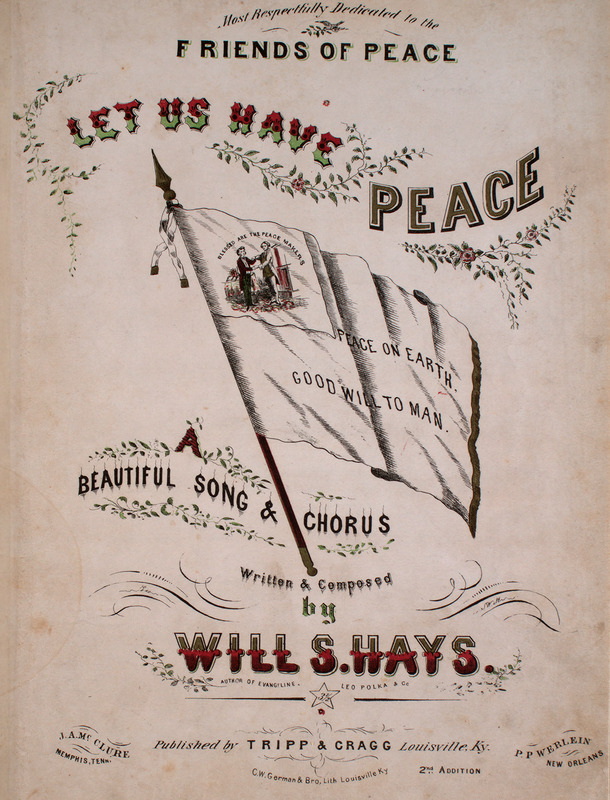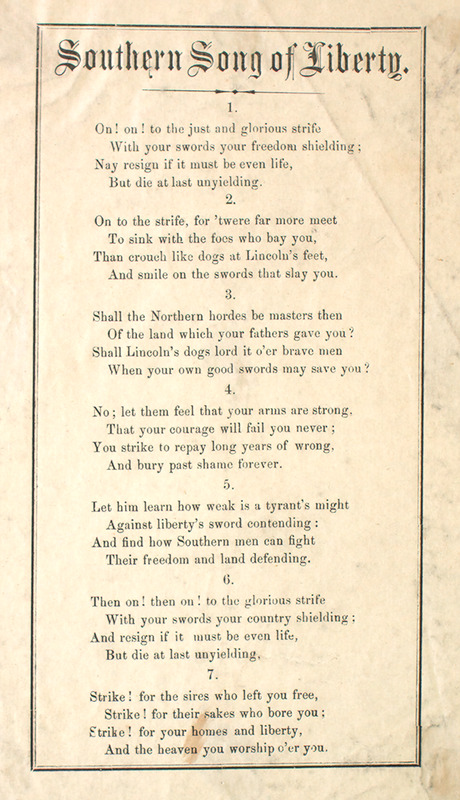Civil War
Three months into the Civil War (1861-1865), the Confederate Constitution was adopted by Alabama, Florida, Georgia, Louisiana, Mississippi, South Carolina, and Texas. The document states, "In all such territory the institution of negro slavery, as it now exists in the Confederate States, shall be recognized and protected by Congress and by the Territorial government."
Alexander Stephens (vice president of the Confederate states) in a speech just prior to the Civil War, claimed, "[The Confederacy's] corner-stone rests upon the great truth, that the negro is not equal to the white man; that slavery-- subordination to the superior race-- is his natural and normal condition."
Sheet music was published throughout the Confederacy during the war, containing mostly themes of unity and loss of culture-- themes that are echoed by white supremacists today. Music was a key tool in recruitment and maintaining troops' morale-- one Southern music publisher noted, "The South must not only fight her own battles but sing her own Songs and Dance to music composed by her own children." (Abel 1)
"Let Us Have Peace" was published in Louisville, KY in 1861 (the year the war started). There were far fewer songs published in the South due to a lack of resources, but the Levy collection contains about 400 of them (boxes 93-95). Many songs from the South were also published anonymously for unknown reasons, but this one comes from well-known composer William Shakespeare Hayes, who was born in Kentucky and wrote over 350 songs in his career.
The cover is filled with 'peaceful' imagery- the song is dedicated "most respectfully to the friends of peace," and shows an early Confederate flag with the words, "Peace on earth, goodwill to man." There is also an image of two brothers shaking hands. The lyrics appear to be anti-war, asking "America, beloved land, once beautiful and bright, oh why should friendship turn to hate, oh why should brothers fight?" However, a later lyric claims "Tis worse than vain for you to try to subjugate the South." This juxtaposition of a plea for peace with a warning against 'subjugation' might make an audience feel proud and powerful, while ignoring responsibility for the actual cause of the war.
The last line of the chorus is, "May our country live again in happiness and peace," (italics supplied) -- the composer is clearly seeking a return to the status quo. Of course, we know that not all living in Kentucky in 1861 were experiencing the happiness and peace Hayes is referring to. Similar "return to the status quo" rhetoric can be found today, including "Make America Great Again."
"Southern Song of Liberty, " with no listed composer, publisher, or date, is in the form of a broadside (song sheet)-- a sort of pamphlet that was easier and cheaper to produce and distribute. Most broadsides contained only the lyrics of the song, as well as the name of a well-known tune, allowing someone to substitute the printed words. Interestingly, this broadside has no tune listed, possibly implying the audience would be familiar with it already.
The text here invokes similar themes to "Let Us Have Peace"-- unity, loss of culture, and recruitment. The third verse asks, "Shall the Northern hordes be masters then Of the land which your fathers gave you?" which is answered by the fourth verse: "No; let them feel that your arms are strong, That your courage will fail you never, You strike to repay the long years of wrong, and bury past shame forever."
"The Song of the South," calls for recruitment and unity against a common foe, drawing on the theme of pride, pleasure, solidarity, and loyalty rather than outrage/anger. It was composed by James H. Huber in 1861 (Lousville, KY) and "Respectfully dedicated to the Sons of the South." Another version of the song appeared in Tennessee, with words attributed to Lena Lyle and an inscription "Kentucky and Tennessee Join Hands." The text of the title in the second version also appears to be drawn in blood, rather than the patriotic-looking text in the Kentucky version (this may have been a choice by the publisher rather than the composer). Between at least these two versions, the song had distribution in Tennessee, Kentucky, Mississippi, and Louisiana.
The music is marked "Maestoso" at the beginning, meaning "majestically." The lyrics contain various calls to action, including "Sons of the South, Arise! For never shall fall upon her, the land we love all the earth above," and "Southern boys for their fireside joys, with their hearts so brave and tender, Will relentlessly fight, and to death dark night."
The back of the song (above) has a report on the adoption of the Confederate flag-- while most sheet music has historically contained advertisements on the back cover, this song was used to distribute information instead. The members of the flag adoption committee "were proud of their race and lineage, proud of their heritage in the glories..." Rather than modifying the stars and stripes, the committee "felt no inclination to borrow at second hand what had been pilfered and appropriated by a free negro community, and a race of savages."



